![]()
![]()
![]()
Use LEFT and RIGHT arrow keys to navigate between flashcards;
Use UP and DOWN arrow keys to flip the card;
H to show hint;
A reads text to speech;
97 Cards in this Set
- Front
- Back
|
what are 8 things you do with a strip
|
1. lable waves
2. p wave normal (upright, alike) 3. PR interval (3-5) 4. P: QRS 5. regularity (R-R distance) 6. QRS wave (<3) 7. symptoms 8. t-wave 9. st segment 10. rate 11. PVC |
|
|
What are the determinants of cardiac blood flow in healthy subjects? (3 factors)
|
1. Mechanical factors (driving pressure or DBP, extravascular pressure, diastolic filling time)
2. metabolic factors (hypoxia) 3. neural influences (SNS, PNS) |
|
|
***What are the effects of atherosclerosis?***
|
Decreased Driving pressure beyond lesion --> ischemia
Ischemic myocardium doesnt relax fully, leading to: 1. increased systole, decreased diastole 2. decreased left ventricle compliance 3. increased Left ventricle EDP --> causes a further decrease in drving pressure --> increased ischemia |
|
|
ischemia causes the heart muscle to _______________ and typically leads to _______. thus increasing/decreasing _______ and _______
|
work less efficiently
arrhythmias decreasing cardiac output and ejection fraction |
|
|
Effect of HTN on the failing heart
|
Stresses the heart further by
Increasing afterload If chronic HTN --> LV hypertrophy --> increasing demand OR need for oxygen |
|
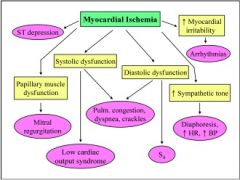
Explain this diagram
|
aaff
|
|
|
List the four mechanisms of coronary artery obstruction
|
1. complete obstruction by lesion
2. obstruction + thrombus = Total occlusion 3. obstruction + coronary aa spasm = pritzmetals angina 4. near total obstruction + high MVO2 |
|
|
Obstruction + thrombus
|
Occlusion of LAD, blood cant get downt to ant apex. necrosis. cells die and release chemical components into the blood stream. triggers and immune response. inflammation and wound healing. scar formation. cardiac cells die and they dont regenerate. filled with fibrous scar. takes 6-8 weeks to form.
after Heart attack dont want to give them a bunch of exercises because it increases pressure and work load on the heart. |
|
|
Complete obstruction by lesion
|
arteries cut open. endothelial layer should be smooth. these are plaques that have formed. vessel shown had a complete obstruction
|
|
|
***list the three types of clinical syndromes***
|
1. stabile angina
2. unstable angina 3. myocardial infarction |
|
|
***Stable angina***
|
typically occurs with activity, resolves with rest.
usually very predictable. at a set heart rate, set BP, know when its going to come on. |
|
|
***unstable angina***
|
occurs at rest OR with activity below usual ischemic baseline ... Two types:
1.) angina at rest. more severe, more problematic. more dangerous if pt has pain at rest. Unstable angina 2.) for a pt that has a hx of stable angina, now its coming on sooner, which means its worse. --- they know they have a hx of stable angina, make sure they have their perscription with them. know where it is. Technically they have to take the pill (under their tongue) by them selves. nitroglicerine is supposed to burn and if it doesnt it may be expired or deactivated. -> dialates the vessels, decreases pressure. they can take up to three doses (in 5 min intervals) and it still hasnt gotten better, call 911. Defined as the presence of signs/symptoms of inadequate blood supply to the myocardium in the absence of demands that usually provoke this imblanace. call 911 or initiate emergency procedures |
|
|
Myocardial infarction
|
occurs with prolonged or unmanaged ischemia. different amounts of blockages to the coronary arteries. organization of a thrombus - body may try to reorganize but by the time it does the tissue distal to the thrombus is already dead.
true death of myocardial cells - once theyve had the infarct occurs due to prolonged or unmanaged ischemia |
|

explain this diagram
|
irritibility in area. dead tissue doesnt contract. not ejecting blood well --> drop in BP, not much is getting past the aortic valve -> poor coronary artery perfusion -> ischemia of the heart. mural (ventricular) thrombus = clot in one of the chambers of the heart --> embolism.
dead tissue (where is it located). if the papillary muscle dysfunction --> lose function of the mitral valve. if in the interventricular septum --> high enough pressure it could rupture = ventral septal defect (VSD) --> mixing of blood, typicall highly oxygenated blood in the. if located in the L circumflex --> L lateral wall became necrotic and died (trying to heal this area) --> this could rupture if there is enough of an increase in pressure --> blood leaking out of the heart into the pericardial sac --> cardiac tampanade --> heart suffocates itself because the fluid is pushing against it. |
|
|
Clinical courses
|
sudden cardiac death - with one hour in the ER = #1 course
Chronic stable angina unstable angina Myocardial infarction yeilding cardiac mm dysfunction = death of some muscle, necrosis, part of the heart cant pump, and no longer has electricity running through it |
|
|
Sudden cardiac death
|
in 20-25% of patients, sudden cardiac death (death within one hour) is the presenting symptom
cause of death is ventricular fibrillation, leading to cessation of cardiac output bystander CPR and entry into the emergency medical system within 10 minutes provides the only hope for survival. - so impt that you know your CPR. in adults when they have this problem, the electrical wiring goes, really need a defibrillator |
|
|
***Angina pectoris***
|
as a blood vessel becomes occluded by a plaque or mm spasm, supply is limited and unable to keep up with demand, often resulting in chest pain or a variety of associated sx referred to as anginal equivalents - i.e. as blood gets narrowed, supply and demand is off. start to see pain in some people. could also just be that you have low BP, not getting perfusion of the blood into all of the coronary arterries. patiet can be dehydrated
demand exceeds supply resulting in ischemia or death of the myocardium also seen with HTN or blood loss |
|
|
***Location of typical anginal patterns***
|
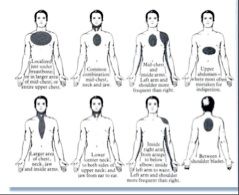
substernal chest is most common. and then down the L arm in the ulnar nerve distribution. pain in the jaw. or in between the shoulder blades
females tend to have more vague symptoms. heart attack - heart is failing to pump blood out. brain will turn on the SNS to try to get blood up to brain. Associated symptoms = naseua, vomitting, sweatting. females = feel sense of impending doom, really tired, really fatigued. |
|
|
***Levels of angina/ angina graded***
|
higher the number = more severe = they have pain
Level I: initial perception of discomfort. reflects a minimum level of discomfort Level II: initial discomfort has intensified over the same approximate body area, or presence of referred discomfort to another area Level III: initial discomfort has become so severe that the pt stops whatever he/she is doing and seeks medicinal relief Level IV: same severity of discomfort as that experienced during a heart attack |
|
|
***chronic stable angina***
|
has a well established level of onset
can be reliably predected with a set level of myocardial demand predictable level of physical or emotional stress can be controlled with a reduction in intensity of activity or by taking nitroglycerin location varies with individual behavior or pain/discomfort: worse with activity, better with rest. not reproduced with palpation. same diagram for pain. draw your pain. ask what brings on your pain - Aggs/eases. helps differentiate pain above the waist is highly suspicious. any time pt has pain above the waist you should screen the GI system and the cardio pulm system. check out their skin - shingles?. worse with activity, better with rest, semi recumbant position. Pt has and takes their nitroglycerine up to three doses. if the pain does not go away - 911 |
|
|
***clinical cues for unstable angina***
|
angina at rest
OR occurrence of the pts typical angina at a significantly lower level of activity than usual deterioration of a previously stable pattern i.e. angina occurring several times a day vs. several times a week. evidence of loss of previously present myocardial reserve, such as a drop in BP or increase in HR with levels of activity previously well tolerated. |
|
|
***other sources of chest pain***
|
MSK
pulmonary integumentary Chest pain of cardiac origin = medical emergency |
|
|
evolution of an myocardial infarction
|
The process of infarction involves either a single event or a series of events through which the infarction progresses gradually
changes in the myocardial tissue begin within 15 mins. after the tissue becomes hypoxic |
|
|
site and extent of myocardial infarction depends on:
|
1. anatomic distribution of aa
2. adequacy of collaterals (do they have adequate collaterals - if they worked out alot, they would have more collaterals formed. if they have a heart attack when theyre young the HA is more massive and more deadly. ) 3. presence and extent of prior MI 4. amount of myocardial demand |
|
|
what are the stages of myocardial infarction
|
stage 1: ischemic myocardium
stage 2: cells in the middle begin to die (dead tissue is non functional, and the surrounding cells supplied by collaterals are minimally functional stage 3: the area of dead cells grows - some cells in the minimally functional area give in to prolonged mild ischemia. dead cells are eventually replaced by fibrous scar tissue, which further shrinks with time. Minimally functional area shrinks with better collateral function |
|
|
myocardial infarction and EKG
|
on the EKG you will have inversion of the QRS upon the onset of ischemia.
with tissue injury, the ST segment changes. also might see q wave become more prominent |
|
|
transmural myocardial infarction
|
extends through the subendocardial tissue to the outer layer of the myocardium = full thickness.
|
|
|
Subendocardial myocardial infarction
|
subendocardial layers, weakness on inside but some part is still contracting
involves only the innermost layer of myocardium and sometimes portions of the middle layer - better prognosis than transmural MI patients are more stable but if you progress their work load you could progress it towards a full thickness MI. so make sure you dont over do the workload. |
|
|
***symptoms of myocardial infarction (8*)***
|
Angina: central chest or substernal discomfort (may radiate to arm, scapula or jaw. May wax and wane, not relieved by NTG).
SOB Diaphoresis - excessive sweating Light headedness nausea and vommiting weakness hypotension tachycardia 20-25% are silent = no symptoms |
|
|
***What can a 12 lead EKG tell us***
|
rate, rhtyhm, myocardial infarction. tell us area or vessel.
take home message, an EKG can tell you abou the location of an MI |
|
|
dominance
|
occlusion of the R posterior coronary artery led to ischemia to the posteior wall of the L ventricle
|
|
|
Looking at the ST segment
|
ID the isoelectrical line between two consecutive PR intervals
find the J point = break point between the end of a QRS and the start of the ST segment. from the QRS complex, move to the R 2 small boxes. depression measured in mm - each small box is 1 mm will tell you about myocardial ischemia |
|
|
ischemia on an EKG
injury on an EKG infarction on EKG |
inversion of the T wave
elevated ST segment AND inverted T wave. prominant Q wave, elevated ST segment, Inverted T wave |
|
|
subendocardial MI EKG
Transmural MI EKG |
new T wave inversion OR ST depression OR both that persist for >48 hours. NO changes in Q or R.
ST elevation associated with T wave inversion. Q wave. Increase or decrease in R wave |
|
|
Serum enzymes
|
CK = creatine kinase = CPK
LDA = lactate dehydrogenase Troponin myoglobin |
|
|
"peak" times and CPK, LDH, torponin
|
CPK = only present for 6 days after onset of chest pain. peaks at day 1
LDH: present for 14 days, peaks at day 4 Troponin: present for 14 days, peaks at day 2 all enzymes are above normal |
|
|
***Complications after myocardial infarction (8)***
|
1. infarct extension (arrhythmias, bradycardia, SVT etc)
2. myocardial dysfunction 3. acute LV failure, hypotension, shock 4. mechanical rupture (rupture of papillary mms, VSD) 5. myocardial ruputre 6. LV aneurysm 7. pericarditis 8. mural thrombus |
|
|
ventricular aneurysm
|
rupture
blood leaks into the pericardial space causing cardiac tamponade. trapped blood within the pericardial sacs restricts the hearts ability to pump. |
|
|
cardiogenic shock
|
results from drastic decrease in CO.
ischemia mm is uncoordinated systolic stretch - the dying mm bulges outward during systole due to increased pressure. this decreases pumping ability of the heart. result - the heart is incapable of contracting with sufficient force to pump blood into the arterial tree, causing cardiac failure and death of peripheral tissues. this almost always occurs when more than 40% of the LV is infarcted (MI). death occurs in 80% RX: pressors, digoxin, IABP |
|
|
***pathophysiology of MI***
|
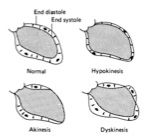
healed infarcts (hypokinesis, akinesis, dyskinesis)
wall motion of a chamber: Normal chamber: ventricle is larger in diastole, ventricle is smaller in systole. HYPOKINESIS: space is smaller indicating under movement/under pumping. still having a contraction just not as strong AKINESIS: part of the ventricle is not contracting DYSKINESIS: dyscoordinated movment, part of the wall is splaying outward. Aka, paradoxical movement bc its movement in a different direction than what you would have expected |
|
|
CHF
|
congestive heart failure - pump failure
since the heart is not able to continue pumpint the blood forward, it dams in the venous system of the lungs or systemic sirculation. CHF can occur on either side of the heart or both. Clinical presentation varies by the location isolate problem or deficit and work circulation backwards to determine where the fluid will back up. something wrong with aortic valve/mitral valve, start to back up towards the ___ . at first might hypertrophy, and then from there it will back up into the R atria. atria is very thin wall. at first will try to expand to except this new fluid. onver time it starts to back up into the vena cava. may see more fluid in the extremities, prominent jugular veins, fluid in the abodmen. L sided problems back up into the pulmonary circulation = problems with breathing. can also cause the R side of the heart to fail. or a bunch of pulmonary diseases that raises the pulmonary pressure can also cause r sided heart failure |
|
|
Compensated heart failure
|
if CHF - if the demand to move fluid through the system is in excess of what the heart can handle, there are compensatory mechanisms that exist to ease the demand on the heart:
1. SNS stimulation; increases CO to supply tissues - get faster HR and stronger contraction to better supply tissues. 2. sodium and water retention by the kidneys - decreased CO from failing hearth 'fools' kidneys into thinking there is not enough fluid volume, so the kidneys hang onto more fluid to increase plasma levels. kidneys thing the person is dehydrated so they start to hold onto fluid - fluid retention causes the heart to struggle even more 3. dilation of the cardiac mm to accommodate the increased volume. alters the length tension relationship; helpful at first but doesnt last very long 4. ventricluar hypertrophy if compensatory measures work pt will be at risk only in situations of increased myocardial demand |
|
|
chronic heart failure
|
with CHF; this develops gradually as the pt relies on compensatory mechanisms to assist the heart in keeping up with the demand.
with time, the chronic overuse of compensatory mechanisms may lead to end organ failure, as the organs (eg kidneys) fail due to chronic overuse. [usu see kidney dz and heart dz together] the heart stretches over beyond optimum length, less cross bridges are formed and the contraction weakens. the heart is more bulbous. already stretched at rest. decreased contraction bc decreased number of cross bridges. |
|
|
uncompensated heart failure
|
this occurs when, despite systemic attempts at compensation to ease the demand on the heart, the heart cannot maintain adequate cardiac output.
eventually the heart becomes so stretched in its attempt to keep up with he demand that it cannot pump any blood, and the pt dies. basicallly, when compensations fail, can keep up anymore --> death or a heart transplant |
|
|
***Pathophysiology of L heart failure***
|
1. intrinsic (ASHD, cardiomyopathy)
2. excessive workload (HTN, valve dz, congenital defect) 3. arrhythmia (bc they decrease cardiac output) 4. alcohol, drug toxicity, irradiation occurs when the LV is u/a to overcome the pressures in the atrial system or stenosis of say the aortic or mitral valve. --> blood/fluid backs up into the lungs, causing pulmonary edema. the fluid doesnt get into the alveoli of the lungs, but causes swelling of the parenchymal tissues of the lungs, hence pulmonary edema |
|
|
pulmonary edema
|
fluid leaks into the interstitial space. swelling of the lung tissue itself. shortness of breath.
occurs with L sided heart failure |
|
|
***Signs and symptoms of L sided CHF (14)***
|
1. SOB
2. orthopnea (SOB when lying flat) 3. paroxysmal night dyspnea (sudden) 4. cough (non productive) 5. fatigue 6. rales (begins in lower lung fields and progress cranial 7. third heart sound 8. pleural effusion - fluid in the pleural space 9. increased RR/tachychardia 10. decreased urine output - kidneys hold onto fluid, but they are also given a diuretic drug to increase urine output. 11. pink, frothy, blood tinged sputum 12. LVH, EKG/cardiomegaly on CXR - EKG shows enlarged heart or on x ray 13. sudden weight gain (>3 lbs per day) 14. decreased exercise/activity tolerance. |
|
|
***Pathophysiology of R sided CHF***
|
occurs when the R ventricle is u/a to produce enough force to overcome the pressures in the pulmonary system
--> the fluid from the R side of the heart backs up into the venous system |
|
|
***Signs and symptoms of r sided heart failure (12) ***
|
1. abdominal pain
2. anorexia/nausea - not wanting to eat, feel too bloated, nausea may be due to SNS 3. bloating 4. fatigue 5. ankle swelling 5. distended jugular veins (JVD) - observed in 45º angle position, occurs when fluid backs up into venous system, increased pressure in the veins causes a visible pulse in the juguar veins 6. hepatomegaly/splenomegaly 7. ascites - fluid in abdominal cavity, shiny skin, hard/firm 8. elevated CVP, R atrial pressure 9. fourth heart sound 10. peripheral edema - pitting edema 11. decreased urine output 12. decreased exercise tolerance |
|
|
B type natriuretic peptide (BNP)
|
released from cardiac ventricles in response to increase wall tension.
cut off point of 100pg/ml rule out CHF with value of <100 used to differentiate cause of dyspnea as BNP increases the likelihood and severity of CHF increases |
|
|
Ascites
|
free fluid in the abdominal cavity. when too much fluid is backed up into the venous system, sometimes the body will dump fluid into the body cavities (also happens in the pleural cavities)
|
|
|
Other possible causes of CHF (besides MI) (13)
|
1. HTN
2. CAD 3. arrythmias 4. renal insuffiency 5. pericardial effusion 6. myocarditis 7. pulmonary embolism 8. valvular heart dz 9. pulmonary HTN 10. age 11. congenital 12. SCI 13. fluid overload |
|
|
causes of rhythm/conduction disturbances
|
ischemia/cad
myocardial injury metabolic/electrolyte imbalances drugs |
|
|
diagnosis of rhythm/conduction disturbances
|
ekg
|
|
|
signs of rhythm/conduction disturbances
|
1. perception of irregular beats varies widely
2. chest discomfort, lightheaded, weakness, fatigue, hypotension, syncope, dyspnea 3. sudden death |
|
|
cardiomyopathy (dilated, hypertorphic, restrictive)
|
dilated: stretched ventricle results in marked systolic dysfunction. example: R atrial dilation possibly due to tricuspid regurgitation
hypertrophic: thickened ventricular myocardium takes up room inside ventricular cavity resulting in decreased filling during diastole. hypertrophy of the heart with exercise restrictive: endocardial scarring of ventricles results in both decreased filling in diastole and decreased force during systole. scar tissue does not stretch during diastole or contract during systole |
|
|
pulmonary embolus
|
when a clot travels from the body into the R heart and then to the pulmonary artery or branch, it cuts off blood flow to a portion of the lung. Size of infarct depends on size and location of the clot. the more proximal the more severe. Worse off increased afterload to R heart and decreased blood flow to the L heart.
|
|
|
SCI and CHF
|
CHF can occur in acute stages of SCI (esp higher SCI) because of unopposed parasympathetic nervous system outflow, as sympathetic nervous system input to the heart is interrupted by transection of the cord.
|
|
|
Atrial /ventricular septal defect
|
a hole in the septum between either the atrias or the ventricles results in flow of blood back and forth and a mixing of oxygenated and deoxygenated blood
|
|
|
patent ductus arteriosus
|
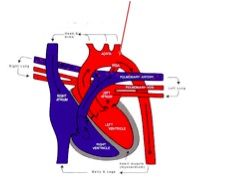
the shunt normal in fetal circulation, should could upon birth. failed closure results in blood flowing back into the R side of the heart.
|
|
|
coarctaation of the arota
|
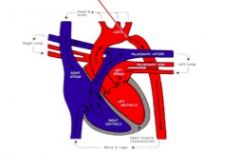
congenital defect where narrowing results in high BP before the coarctation and low BP after.
often UE/upper body and LE/lower body have the differing BP. presentation: HTN, cold legs/feet, CHF |
|
|
Tetralogy of fallot
|
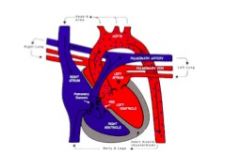
BAD combo of defects causes increased right afterload, mixing of oxygenated and venous blood
|
|
|
aging results (5)
|
increased stiffness/fibrosis
decreased lean body mass decrease response to SNS increased time for repolarization of cardiac mm heart is less efficient |
|
|
cardiovascular changes of CHF
|
decreased pumping ability of heart yields systemic vascular constriction to attempt to increase cardiac output and stroke volume
|
|
|
pulmonary changes of CHF
|
pulm. edema leads to decreased gas exchange
|
|
|
neurochemical changes of CHF
|
reflex SNS stimulation eventually leads to desensitization to SNS neurotransmitters
|
|
|
renal changes of CHF
|
retains water to improve perfusion of the kidney which further increases workload for the failing heart
|
|
|
hepatic changes of CHF
|
potential cirrhosis from decreased perfusion of venous congestion
|
|
|
Hematologic changes of CHF
|
polycytemia and hemostatic abnormalitites from decreased O2 transport
|
|
|
pancreatic changes of CHF
|
potential decreased insulin secretion and glucose tolerance
|
|
|
nutritional changes of CHF
|
ascites causes anorexia and therefore decreases nutrition
|
|
|
msk changes of CHF
|
skeletal mm wasting and osteoporosis
|
|
|
valvular stenosis
|
due to the restricted valve opening, creates a pressure and volume load on the chamber preceding the abnormal valve. the chamber then develops compensatory hypertrophy.
leaflets get stuck together, narrow opening. not much blood can be pumped past this valve. creates increased afterload, increased workload, and hypertrophy of the preceding chamber |
|
|
valvular regurgitation
|
chamber retrograde (behind) initially dilates, followed by hypertrophy because of increased volume
|
|
|
valvular prolapse
|
valve leaflet billows backward
ruptured chordae tendinae. a MI can also result in rupture of papillary mm. both can lead to prolapse. A blood clot can form as a result of the prolapse |
|
|
rheumatic disease
|
age 5-15. after an untreated strep infection
MV 70% AV 30% TV and PV <5% mitral valve disease, regurgitation complication = enlarged L atrium |
|
|
4 steps that lead to atherosclerotic heart disease
|
1. injury (endothelial hypertenion, genenitcs, congenitial, virus
2. platelet aggrigation 3. LDL proliferation/ smooth muscle 4. calcium\ |
|
|
types of valvular heart problems
|
aortic stenosis
aortic regurgitation (acute and chronic) mitral stenosis - increases P in LA, thin atrial walls. mitral regurgitation (acute and chronic) mitral valve prolapse - thin atrial wall can handle |
|
|
explain why some people get HA but dont have high BP
|
o there could be inflammation. heart dz, inflammation, cancer... inflammation followed by wound healing. cells releasing inflammatory markers are cytokines. certain cells release different inflammatory markers. adipokines release and therefore people with alot of fat have chronic inflammation. then you release off inflammatory markers. how can you stimulate the turn off markers.. exercise. released from myokines. will see a dip in off myokines if you cease to exercise for two weeks.
|
|
|
signs and symptoms of valve problems
|
1. heart murmur - valve isnt closing smoothly, wooshing sound
2. thrill - palpable evidence of change in blood flow - fluid shloshes around bc it cant pass smoothly, palpable vibration 3. B rhales on auscultation - gurggling over lung fields 4. weight gain/peripheral edema 5. JVD 6. ascites 7. orthopnea 8. decrease activity tolerance 9. palpitations 10. dry hacking non productive cough 11. paroxysmal night dyspnea PND - sudden SOB awakening patient 12. SOB 13. lightheadedness - if AV or decrease CO - blood cant be pushed forward 14. angina - most often if MV involvement |
|
|
differential dx
|
signs and symptoms of valve problems looks just like CHF. in fact, CHF is the most common complication of valve dysfunction. Either R, L or BL CHF will arise depending on which valve is problematic
|
|
|
valve dysfunction treatment options
|
valve replacement
valvuloplasty valvulotmy commissurotomy |
|
|
valve replacement
|
2 types, mechanical or animal/tissue valve.
if it is a mechanical valve the pt will be on blood thinners for life (because its foreign). if it is a tissue valve they will start on blood thinners but not chronically. tissue valve usually lasts longer than the mechanical valve valves that arent functioning properly are removed and surgically replaced |
|
|
valvuloplasty
|
balloon tip catheter is inflated to open the leaflet and relieve incompetence or stenosis
similar to angioplasty more for people who wont tolerate surgery. opens it up but doesnt close completely so you get regurgitation to open a stenotic valve, may cause a leaky valve. helps to un stick the valve. they dont leave it in. ideal thing is to replace the valve. ideally they would do a tissue valve. they leave this in for 15 seconds. acts to stretch the valve out to maybe stretch out the valve's adhesions. if you dont change your lifestyle or diet you will reocclude. |
|
|
valvulotmy
|
surgical incision through stenosed leaflet to relieve obstruction
clean up the valve. sometimes there are adhesions along the sides of the valve causing opening and closing to be more difficult, stenosis. they go in and cut the adhesions to make it open and close more easily. |
|
|
commissurotomy
|
surgical incision to separte adhered leaflet
similar to a valvulotomy, different based on the extent to which they had to cut. |
|
|
complications to a valve replacement
|
1. thrombosis (pt on blood thinners, does not prevent clots 100% and subsequent embolization)
2. infection (on or around, sometimes septic embolization) 3. structural failure (leaflets become stiff and calcify) 4. dehiscence (separation of the prosthetic valve suture from the heart, leads to paravalvular leakage) 5. disproportion (prosthetic valve not fitting well, blood flow is not optimal) |
|
|
infective endocarditis
|
complication after valve replacement
some infection made its way to your heart and then it grows. can break free and cause clots down stream. go to your weakest link. so i fyou have a weak valve, they tend to grow on the valve. infection ate right through the valve. can infect the cordae tendonae. |
|
|
pericarditis
|
inflammation of the pericardium
can result in pericardial effusion and cardiac tampoade fluid in the pleural space = pericardial effusion. if its blood in the space its called a cardiac tamponade |
|
|
serous pericarditis
|
serous fluid in the pericardium
fibers throughout the pericardium - not going to be able to pump as well. can cause adhesions of the two layers. restrictive pericarditis. constricting the heart wont allow for good filling during diastole. if fiber gets thick enough, two layers can fuse. |
|
|
fibrinous pericarditis
|
if serous pericarditis persists fibers can begin to develop and the two layers adhere to one another. this can cause a constrictive pericarditis which causes a diastolic dysfxn.
|
|
|
constrictive pericarditis
|
this can be treated surgically if recognized soon enough
constrictive percarditis - the pericardium fills with fibers and fuses/adhesions. |
|
|
prululent pericarditis
|
pus in the pericardial sac
|
|
|
hemopericardium
|
this typically follows blunt chest trauma
coagulated blood in the pericardium |
|
|
Chest pain - differentiate, pain pattern, distributinon, aggs, eases.
stable angina. unstable angina pritzmetals = variant pericarditis will add - lung diseases medical screening - GI (reflux disease) liver, diaphragm, referral patterns, integumentary system (shingles) |
?
|
|
|
signs and symptoms of pericarditis
|
1. chest pain (AGGs: anything that puts stretch on it. worse with SB or trunk rotation. worse with deep breaths, better with breath holding, EASES: better with kneeling on all fours, leaning forward, sitting upright)
2. difficulty swallowing - bc its an infection. typicall has a previous infection. 3. hx of fever, chills, malaise, previous heart dz |
|
|
treatment of pericarditis
|
treat underlying cause (ie infection)
antiinflammatory drugs pericardiocentesis as needed |

